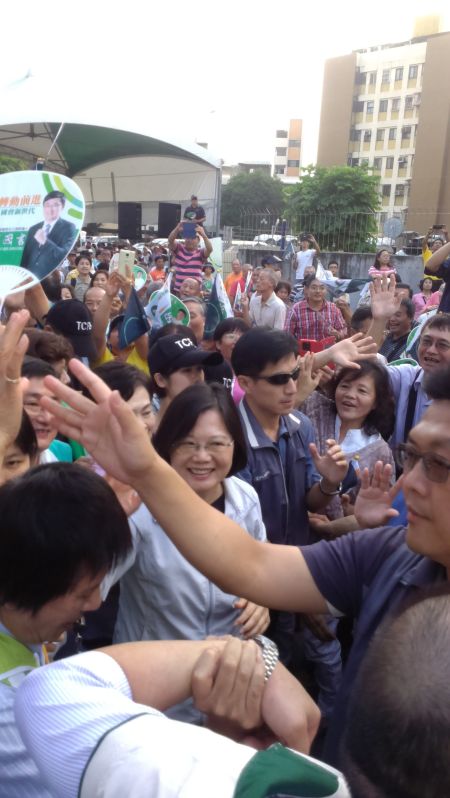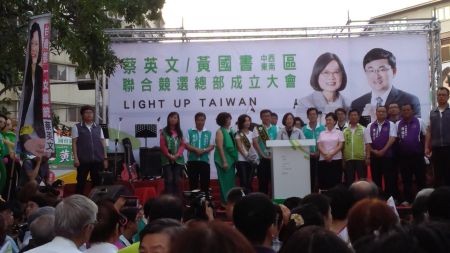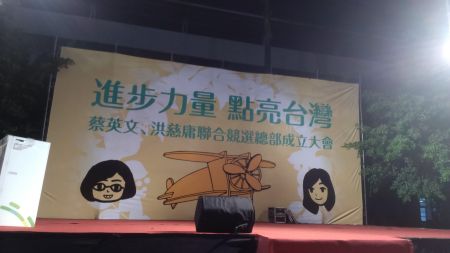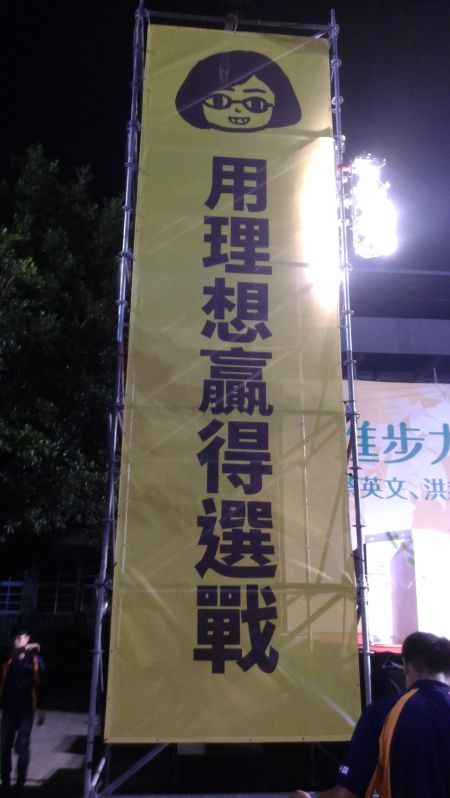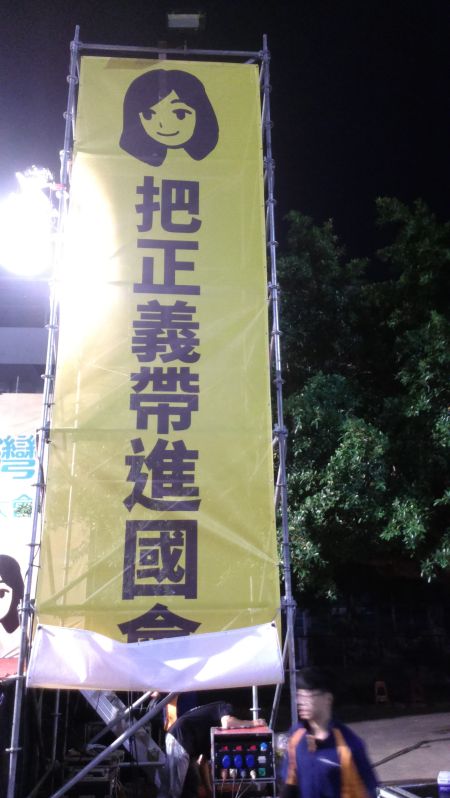This morning Mrs. Garlic and I went to downtown Taipei to watch Chiang Wan-an 蔣萬安 open his campaign headquarters. Chiang is, of course, the great-grandson of Chiang Kai-shek, the grandson of Chiang Ching-kuo, and the son of (former Foreign Minister and KMT Secretary-General) John Chiang. Chiang Wan-an is running in Taipei 3, his father’s old district. I had not seen the youngest Chiang in person, so I was interested to see how polished and charismatic he seemed.
Chiang Wan-an will probably win this race. A few months ago, it looked like the DPP would nominate city councilor Liang Wen-chieh 梁文傑, and Liang would have been a tough opponent. Liang (probably) would have run a campaign about privilege vs personal achievement, seeking to paint Chiang as another spoiled prince like Sean Lien. This looked like it was going to be one of the highest profile races in the country, and given the current national trends there is a chance that the DPP might have stolen this historically KMT district. However, opposition elder Lin Yi-hsiung ruined this by demanding space for small parties and eventually forcing Liang to withdraw. The DPP did not nominate a candidate, and the green vote is now split between two lackluster candidates. Chiang is cruising to a quiet win. I think this might go down in history as the time when Lin Yi-hsiung saved the Chiang family. Wouldn’t that be ironic?
Most of these events are held in a parking lot, a school field, or some other big empty space. This one was held on a major street. They blocked off two lanes of traffic on Songjiang Rd, and had an overflow area on the sidewalk. (Amusingly, there was a car still parked on the side of the road right near the stage when the event started. The owner finally showed up to drive away about 45 minutes after the event started. I’ve never seen that before.) About 2000 people were there. It wasn’t heavily mobilized; about half of the people came as part of a group. By the normal standards of these events, it was a fairly young crowd. It was also quite enthusiastic, especially for a KMT crowd this year. Mrs. Garlic was impressed by how wealthy the crowd seemed. The woman standing in front of her was decked out in expensive jewelry, and the number of elegant-looking people was substantially higher than you normally see at these types of events. Afterward I was chatting with a random person who handed me his name card. He was in the yacht business. Taipei 3 is one of the richer areas of Taiwan, but this crowd was wealthy even by those standards.
The host of the event was a TV celebrity, and he had no idea how to run an outdoor campaign rally. There were lots of awkward pauses, and he wasn’t good at building an atmosphere. He also didn’t understand priorities in introducing VIPs. At campaign-launching events, you need to recognize your core campaign team to make them feel valuable. You also need to let their people know you are about to recognize them. When you introduce someone, you say their position first (and draw it out as long as possible) before stating their name. Ideally, you would say something like, “From Songjiang Li, our Songjiang Neighborhood head, Chen Chien-kuo, Chen Chien-kuo Neighborhood head!” This gives everyone a second to realize what’s going on so they can stand up and all their people can clap for them. The host today introduced a lot of people as “Chen Chien-kuo … Neighborhood head.” And that was it. He did it with a couple of city councilors, too, which is even worse. City councilors are important cogs in your organizational network, and you need to give them as much face as possible. Hosting a political rally is a skill, and it drives me nuts to see people trust amateurs with that job just because they are celebrities.
I wasn’t that impressed with Chiang’s roster of local volunteers. When I went to Zhonghe for Chang Ching-chung’s 張慶忠 rally, they had neighborhood chief after neighborhood chief. It took over five minutes (maybe ten) to run through them all. Chiang Wan-an had far, far fewer. In fact, he introduced far more neighborhood secretaries and party bosses than (popularly elected) neighborhood chiefs. The Chiang campaign also didn’t have nearly as many support organizations as most KMT candidates have, or at least they didn’t parade them up on stage. For a likely winner, Chiang’s organization struck me as surprisingly weak.
Chiang Wan-an was one of the first speakers. He struck me as a raw but promising politician. He has the warmth and outgoing personality to connect with a crowd, but he is still learning his way with the microphone. Electoral politics is difficult; you don’t become a master in just a few months. His speech was mostly fluff. In political science terms, he emphasized valence issues. A valence issue is something that everyone is for. We all want a better economy, happy citizens, and earnest politicians. He talked about how hard he has campaigned, how much he has learned, and how much he wants to help seniors, women, and children. He steered away from controversial issues such as One China, the KMT’s vice president, Ma Ying-jeou, and pretty much everything else relating to national politics. He wanted us to know that he is young, optimistic, and idealistic. He made a big deal out of insisting on positive campaign messages. This is all smart. He is running a front-runner’s campaign. The KMT should have a majority in this race, so all Chiang has to do is convince all of his natural supporters that he is worth supporting. As long as he is not like Sean Lien, he will probably win. The only time Chiang stepped near a dangerous topic was when he discussed his family background. He noted that some people want to label him a second generation politician (note: Nope. They want to label him as a fourth generation politician.), but he responded that he has worked hard to prepare himself for this job and he is proud of his family background and surname. I suppose he has to say something about his heritage, and this is just about the only thing he could say. Still, I hope he isn’t kidding himself. Lawyers are a dime a dozen, and everyone shakes thousands of hands. His surname is the ONLY reason he is going into the legislature.
After a couple forgettable speakers, former presidential candidate Hung Hsiu-chu showed up. I think she really liked being the presidential candidate because she made a presidential entrance. She entered from the back of the space and worked her way slowly up the central aisle like a conquering hero. This kind of entrance is reserved for the candidate and superstars, and Hung must think she is the latter. I watched the crowd as she entered. This was a deep blue crowd, so I expected that she would be treated like a pop idol. Instead, she got a rather ho hum welcome. It wasn’t cold and detached, but it certainly wasn’t crazed passion. I think Chiang Wan-an might have gotten a warmer response when he entered. Hung didn’t say anything controversial in her speech. After this week, I thought she might say something about loyalty to the KMT or hint at running for party chair. (Apparently, she let loose later in the day, attacking the KMT’s VP candidate.) However, all she did was talk about how wonderful Chiang Wan-an was. As she retires from the legislature, she is comforted to know that a new generation is ready to take over from her. At one point, she did get a little ridiculous, claiming that Chiang’s candidacy had absolutely nothing to do with his family background. He grew up just like normal people. (Note: When Chiang was an undergraduate in the department of diplomacy at NCCU, his father was foreign minister and KMT secretary-general. Somehow, I doubt Wan-an was oblivious to and completely unaffected by his father’s power and status. Maybe I’m too cynical.)
The last speaker was Eric Chu. There was a good 20 minutes between Hung’s speech and Chu’s arrival to allow her time to leave. Those two are not on the best of terms right now, and it would have been awkward if he arrived while she was still there. Chu did not make the long heroic entrance through the crowd. Instead, Chiang Wan-an chauffeured him in his car, and they drove right up on stage, something I can’t recall seeing before. This was a really nice bit of theater, though I’m not sure how many people in the audience appreciated it. Chiang Wan-an has been driving a car (with his campaign logo) around the district. When he sees someone hailing a taxi, he pulls over and offers them a free ride. During the ride, he answers their questions about his candidacy. These conversations are all recorded, and he posts the best videos on his facebook page. It’s a nice little gimmick, making him seem down to earth and accessible. I’m guessing this was also conceived as a defensive measure against attacks that he is another Sean Lien. Lien famously drove a Porsche and seemed to have no clue how regular people lived. Chiang is driving an economy car, and he is comfortable giving rides to ordinary riff-raff.
Chu gave a much more impassioned speech than I’ve seen at previous events this year. He castigated the DPP for its antagonistic attitude toward the mainland, saying they weren’t interested in constructive cross-straits relations. He spoke of the need for mutual respect and trust, and only then could the two sides realize mutual benefits. He insisted that only the KMT could properly manage the cross-straits relationship. If the DPP took power, cross-straits relations would inevitably go backwards. (Note: My memory is a big fuzzy on the specifics of Chu’s speech, so I might be missing some nuances.) Chu did not speak about his VP candidate or any specific policy proposals. He did mention food safety, expressing outrage that the courts had found the Ting-hsin bosses not guilty and demanding an appeal. He also tried to frame this constructively. The legislature would need to write new laws, and Chiang Wan-an has the legal training to write good laws to construct a better system to monitor food safety. I thought that was a bit disingenuous. The problem has never been that the laws were written by stupid or inept people. The problem is that the people writing the laws didn’t want to build a rigorous (read: expensive) monitoring system that would prevent food companies (read: political allies) from cutting corners and making large profits. Chu didn’t say anything about those sorts of motives.
When Chu finished, everyone quickly cleared out. Everyone knows that when the main speaker finishes, the event is over. (I once went to an event where the main speaker showed up early and the candidate – who was holding his first major event in his first campaign – didn’t get a chance to speak.) Everyone except the host knew it was over. He kept trying to continue the event. Apparently there were other people who still wanted to speak. They tried to persuade people there was still more, but after a couple of minutes, they finally realized it was futile and gave up.
Perhaps the most successful aspect of this event was something no one talked about. It was not at all well-funded. They held the event on a public street (read: free) rather than renting out a bigger space. They didn’t hand out baseball caps or vests to the people they mobilized. Chiang’s campaign headquarters are small and hidden away in a back alley rather than the more typical ostentatious office on a main road. If the intent was to send a quiet signal that Chiang is not obliviously wealthy like Sean Lien, it was very successful. Really, that might be the most important message of Chiang’s campaign: “I am not Sean Lien.”

Here’s a shot from the back of the space. It’s not a large space at all. We mostly stood on the sidewalk and didn’t have a great angle for taking pictures.

Chiang Wan-an rallies the faithful. He’s got a bit of natural charisma. In ten years, he’s going to be really good on the stump.

Exif_JPEG_420
Hung Hsiu-chu gushes with praise.

Exif_JPEG_420
Eric Chu has his say.
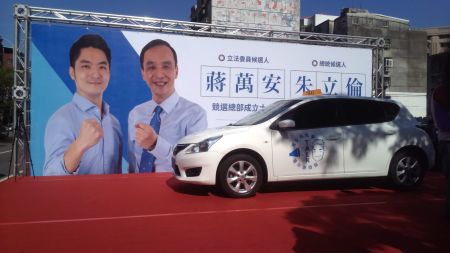
Chiang Wan-an’s “taxi.”
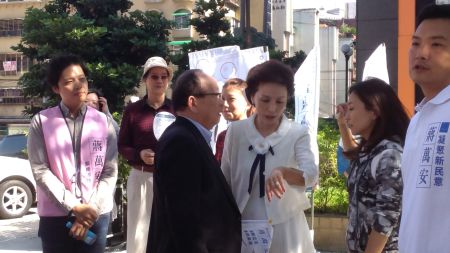
Chiang Wan-an’s parents.
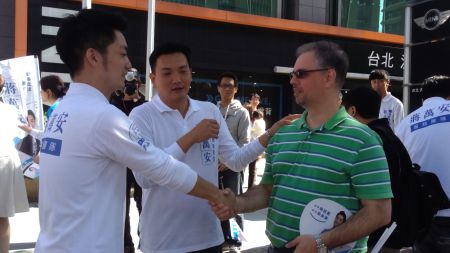
Chiang Wan-an shaking hands with me. I assume the guy in the middle must be some brain dead party hack.



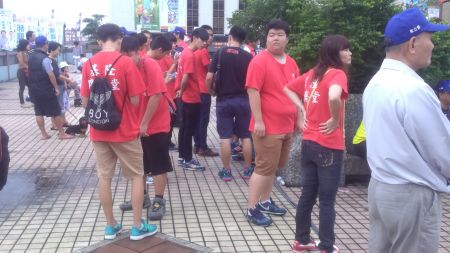



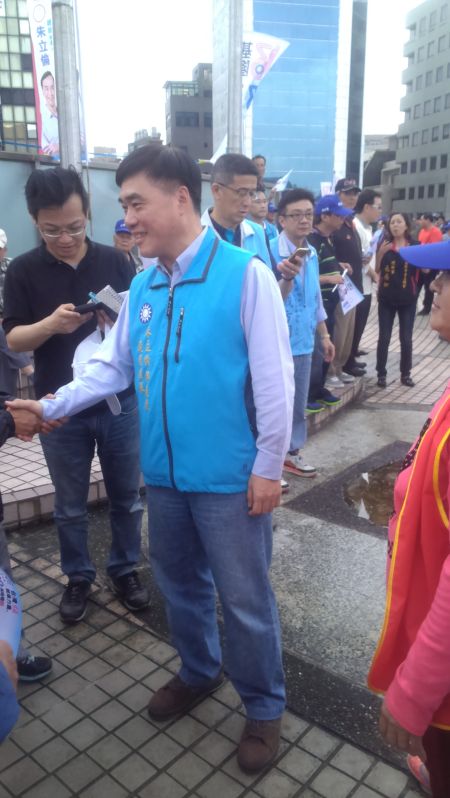

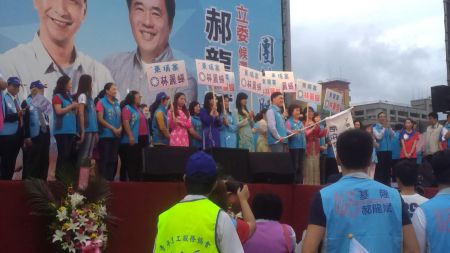



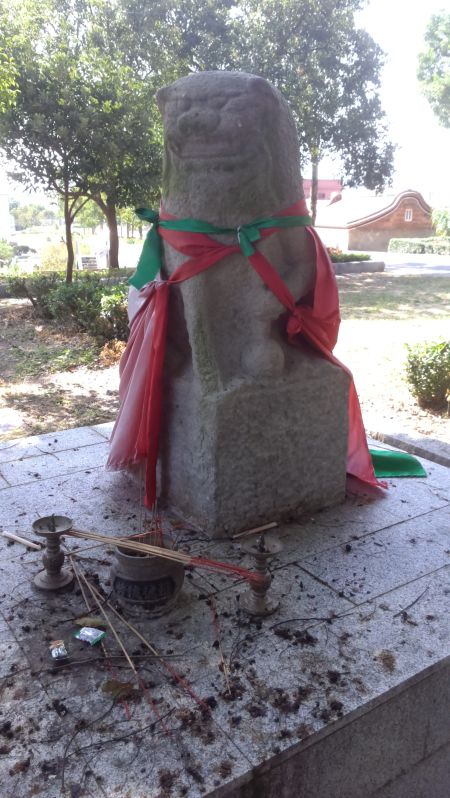
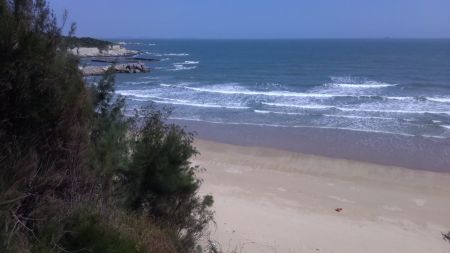



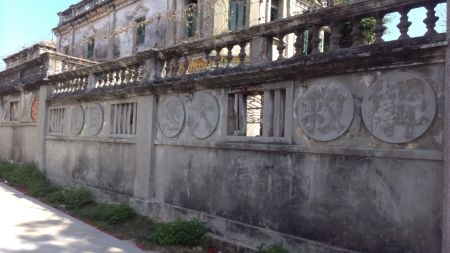


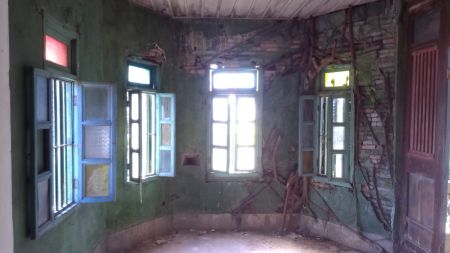

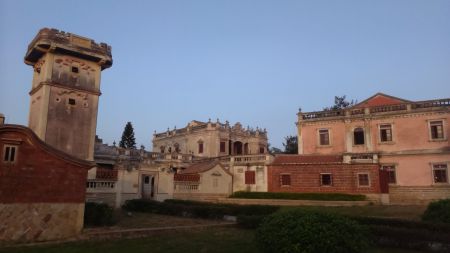

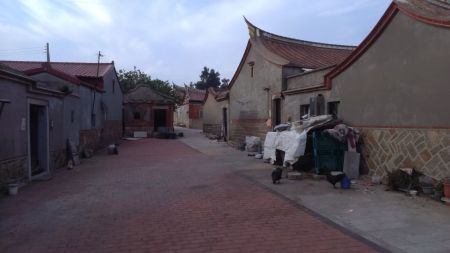



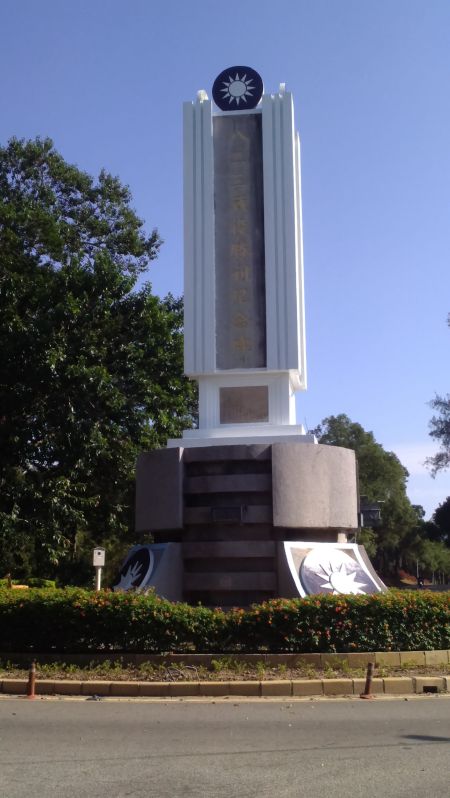




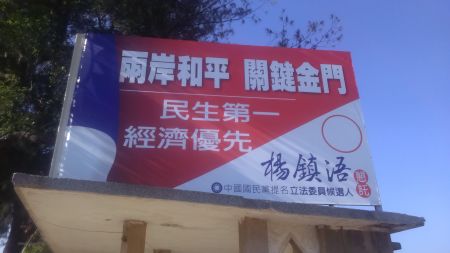
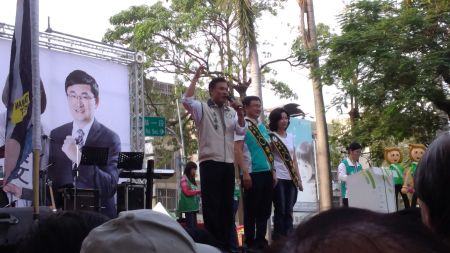






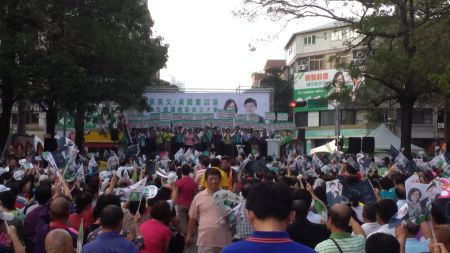



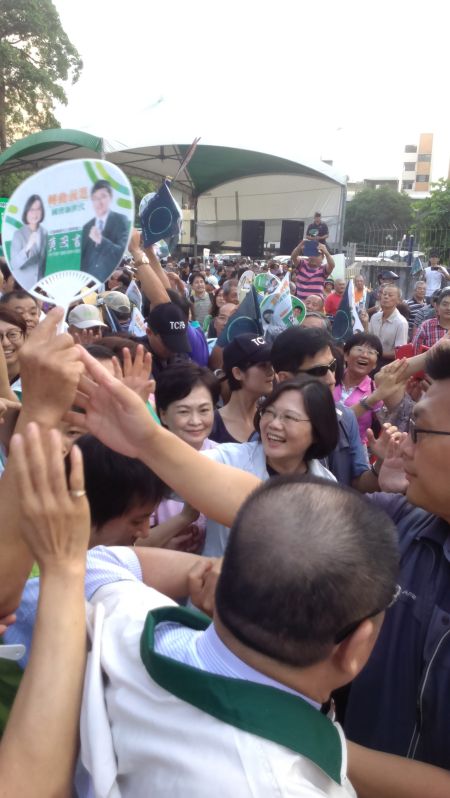 2035
2035